
Original Link: https://www.anandtech.com/show/2709
NVIDIA's Ion Platform: Hands on at CES 2009
by Anand Lal Shimpi on January 13, 2009 12:00 AM EST- Posted in
- GPUs
Remember NVIDIA’s Ion platform, the neat little box we previewed last month? Ion combines Intel’s Atom processor with NVIDIA’s GeForce 9400M instead of the existing Intel chipsets.
NVIDIA invited me to benchmark Ion at CES. A cab ride down to the MGM in Vegas and soon I was escorted up to NVIDIA’s Ion room. Not big on partying, the Ion platform kept a neat, clean and alcohol-free room (the same can’t be said for its bigger GeForce brothers). Sitting on the table were two machines: an Acer Aspire netbook and an Ion reference platform similar to the one I looked at last month.
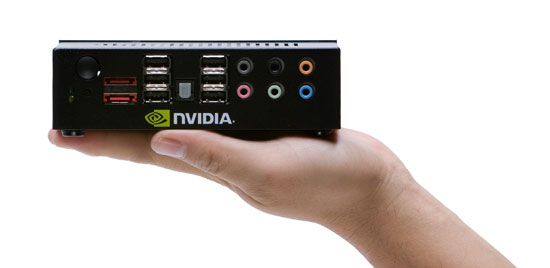
NVIDIA allowed me to benchmark the two systems in a handful of tests, unfortunately the deck was stacked in NVIDIA’s favor. The Ion reference platform had a dual core Atom 330, while the Acer Aspire had a single-core Atom N270. They ran at the same clock speed, NVIDIA’s platform just had twice the cores.
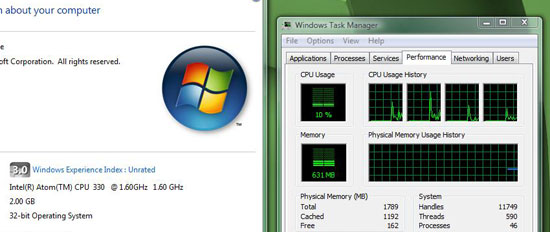
1.60GHz, 2 cores, 4 threads (2 per core) - it's the dual-core Atom 330. Unfortunately the Acer netbook only had a single core
Things got more unfair on the memory side. NVIDIA’s platform had 2GB of DDR3, while the Acer Aspire had 1GB of DDR2. The difference in memory technology was unavoidable, 945G doesn’t support DDR3, but the difference in memory size could’ve been avoided.
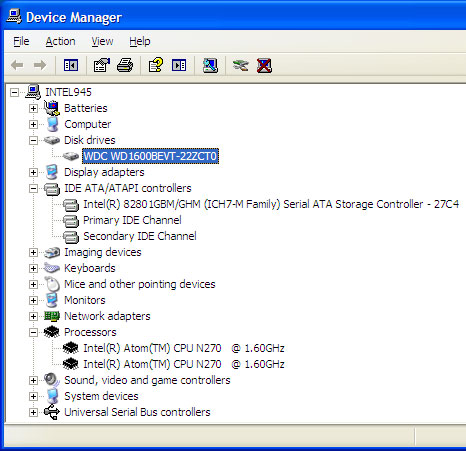
One core (2 threads) and a 5400RPM drive in the Acer netbook
Then there were differences in drives. The Acer netbook used a 5400RPM Western Digital drive, while the NVIDIA Ion reference platform had a 7200RPM Seagate drive in it. Simple things like launching Spore took less than half the time on the Ion system because of this difference.
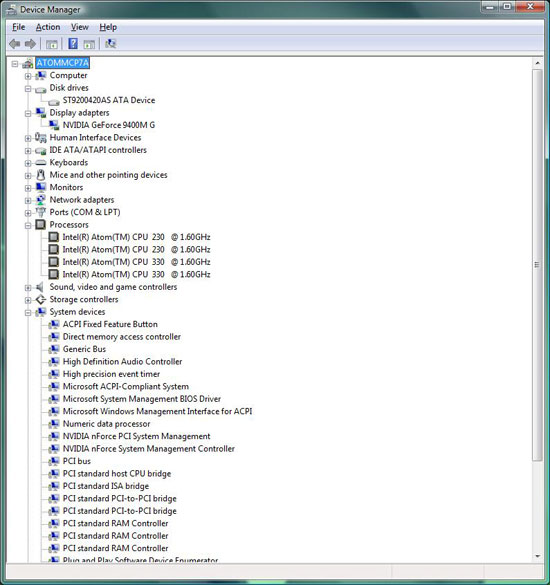
The Ion platform had a more aggressive configuration
While I believe that the NVIDIA PR present wasn’t involved in the unacceptably different setups, someone was, and it made it so I couldn’t compare the two platforms. I could provide you with performance results here, or even usage impressions, but it wouldn’t be fair. I’ll wait until I have hardware in house before making a scientific comparison between the Intel and NVIDIA versions of the Atom platform.
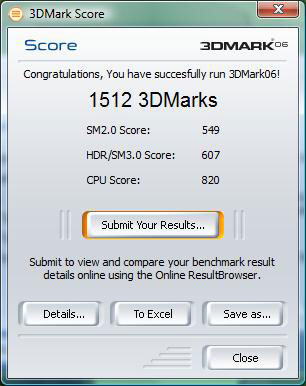
3DMark 06 at 800x600, default settings, on the Ion platform with an Atom 330 and 2GB of DDR3
Obviously NVIDIA’s Ion will play games a bit better, or at least at higher quality settings. For example, you could run Spore on both the Atom + 945G setup and NVIDIA’s Ion at 800 x 600. The frame rates were comparable, but you had to run at Low quality for the 945G setup while you could run Medium on Ion.
Fundamentally I’m not sure I’d really see much of a benefit to Ion in a netbook. The biggest advantage is going to be full hardware H.264/VC-1/MPEG-2 decode acceleration, which you can also get from Poulsbo. The improvement in gaming performance will be there, but I’m not convinced that you’d want to game on a netbook in the first place. They are cramped and the integrated trackpads usually suck; you could always carry around an extra mouse, but that’d defeat some of the portability of a tiny netbook.

Call of Duty 4 won't run on the 945G equipped Acer netbook. NVIDIA's Ion fixes this, I'm just not sure you'd want to play CoD4 on it in the first place.
Now in a Mac mini-esque device, home file server, mini HTPC or larger netbook/notebook the Ion platform starts to make more sense. In the end I prefer having more options than fewer, so bring on Ion based designs and let’s see if/where they make sense.
Understanding Atom: Three Models for the Same CPU
Let me clear up some naming confusing regarding Atom. While there’s only one Atom processor, it comes in two different versions: Silverthorne and Diamondville. Silverthorne is the version intended for use in MIDs (Mobile Internet Devices), it’s a part of the Z5xx series. Diamondville is the version intended for desktops, notebooks and netbooks - it’s the N2xx, 2xx and 3xx series. The N2xx is used for netbooks, while the 2xx and 3xx are used for desktops. The 3xx is a dual core version of Diamondville. The 2xx and 3xx chips simply draw more power than the N2xx. They also support 64-bit instructions, while the rest of the lineup is 32-bit only.
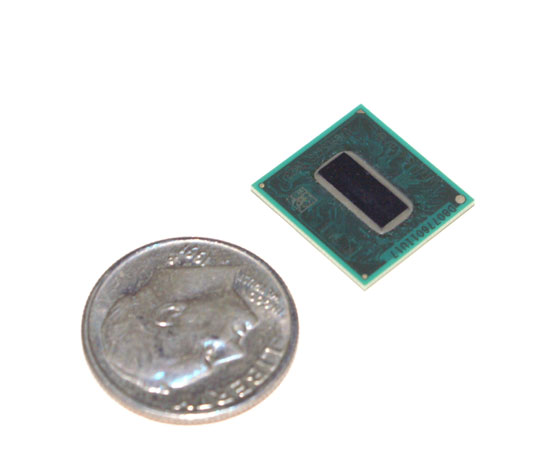
That's Atom, in case you've forgotten
Performance between Silverthorne and Diamondville at the same clock speed is identical. Silverthorne uses a CMOS bus interface instead of a GTL FSB, which consumes less power but also means that it won’t work with conventional desktop chipsets. Silverthorne is thus paired with Intel’s Poulsbo chipset (sold under the UL11/US15 chipset name).
Diamondville supports the standard GTL FSB interface, and will thus work with desktop Intel chipsets. This version won’t work with Poulsbo, but will work with 945G as well as NVIDIA’s GeForce 9400M. Anything that can work with a Core 2 or Pentium 4 processor should be able to work with Diamondville.
Both versions are sold under the Atom name, they simply carry different model numbers. I’ve summarized everything in the table below:
| # of Cores/Threads | Clock Speed/L2 | FSB | 64-bit | Target Market | TDP | Price | |
| Intel Atom 330 | 2/4 | 1.6GHz / 512KBx2 | 533MHz GTL+ | Y | Desktops/Notebooks | 8.0W | $43 |
| Intel Atom 230 | 1/2 | 1.6GHz / 512KB | 533MHz GTL+ | Y | Desktops/Notebooks | 4.0W | $29 |
| Intel Atom N270 | 1/2 | 1.6GHz / 512KB | 533MHz GTL+ | N | Netbooks | 2.5W | $44 |
| Intel Atom Z540 | 1/2 | 1.86GHz / 512KB | 533MHz CMOS | N | MIDs | 2.4W 2.6W w/ HT | $135 |
| Intel Atom Z530 | 1/2 | 1.60GHz / 512KB | 533MHz CMOS | N | MIDs | 2.0W 2.2W w/ HT | $70 |
| Intel Atom Z520 | 1/2 | 1.33GHz / 512KB | 533MHz CMOS | N | MIDs | 2.0W / 2.2W w/ HT | $40 |
| Intel Atom Z510 | 1/1 | 1.1GHz / 512KB | 400MHz CMOS | N | MIDs | 2.0W | $20 |
| Intel Atom Z500 | 1/1 | 800MHz / 512KB | 400MHz CMOS | N | MIDs | 0.65W | $20 |
I had to get that out of the way because some manufacturers are opting to go with Silverthorne for their notebooks, while others are using Diamondville. And the model numbers are different enough to be confusing, despite fundamentally being the same processor. Just to reiterate, an Intel Atom Z530 offers the same performance as an Intel Atom N270, they both work at 1.60GHz.
Will Intel Stop Ion?
The same day our Ion preview went live last month, a story from Digitimes went live talking about how NVIDIA does not have Intel’s approval to manufacture a chipset for Atom.
As far as my understanding goes, Intel can’t prevent NVIDIA from making chipsets for Atom; NVIDIA already has a license for the FSB (although it's unclear if NVIDIA could build chipsets for the CMOS version of Atom, the Z5xx series). Intel can, however, make it financially undesirable for manufacturers to choose the GeForce 9400M. Intel offers bundled pricing on the Atom + 945G or Atom + Poulsbo chipsets, as well as added incentives for doing things like not using Atom in very large notebooks.
Part of this is to protect Intel’s more expensive processor business, but it’s also to protect the consumer: using an Atom on a larger notebook is going to give you the impression that you can do what you would on a normal notebook, when in actuality you’re running hardware that’s about as fast as something from a few years ago and probably don’t want to.
The bottom line is that as far as I can tell, Intel isn’t preventing Ion from happening. It just may be financially more attractive for an OEM to not build an Ion based netbook.
Final Words
That’s it for this Ion update, I hope to have a platform in the coming months to put through the ringer myself. I’ve got some interesting usage models I’d like to test. NVIDIA assures me that I’ll see one as soon as it’s ready.
I’d like to see an OEM system based on it, but so far I haven’t heard anything about Ion from another other than NVIDIA itself.







